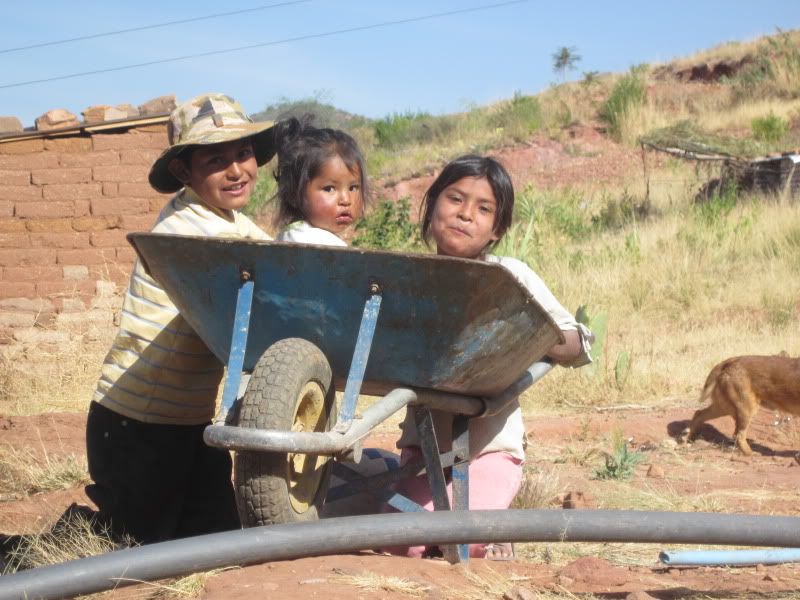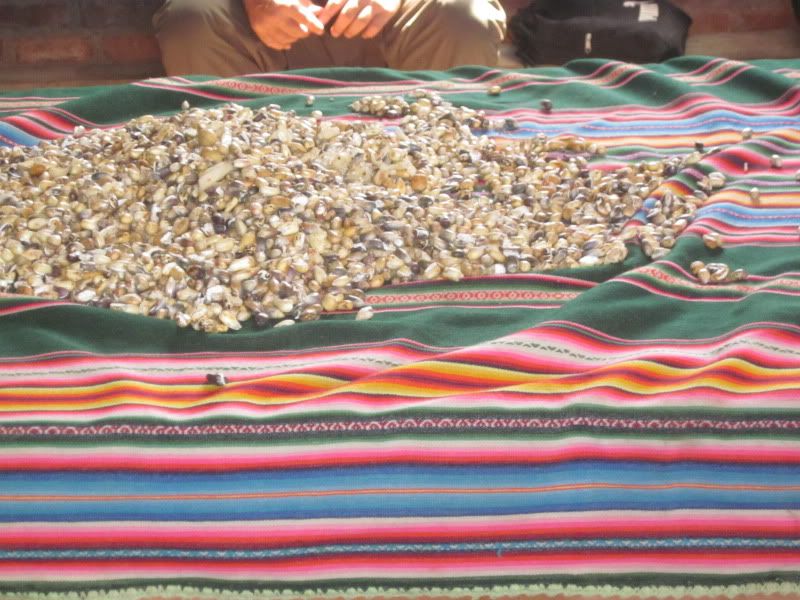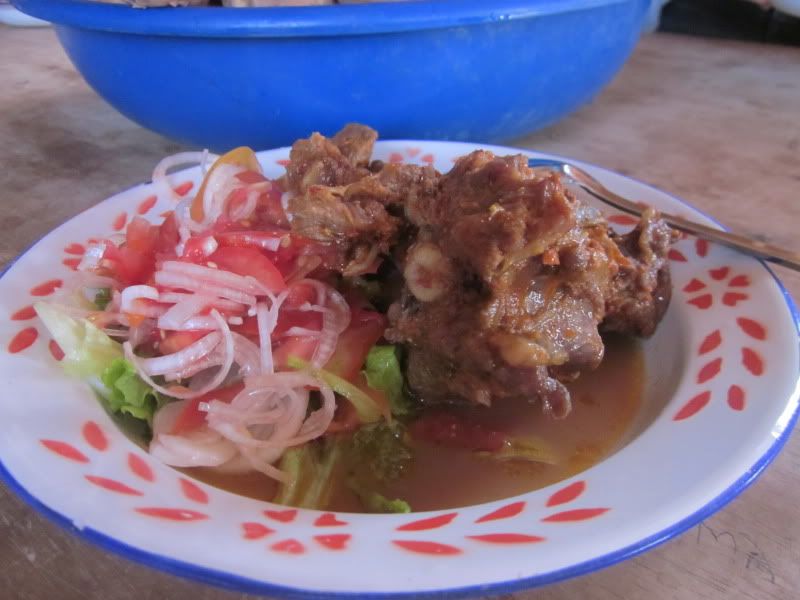Now we go to the Quechua community itself. It is called Linku or Linko - our group could never figure out how it was spelled. Be warned, this diary includes some very cute pictures of children.

When we arrived, we were invited into a large, open building. We sat down in seats, and the people of Linku sat on the floor. I must say, this is quite common in Bolivia from my experience, that the Bolivian indigenous will invite us gringos into their communities and then sit separate from us, usually offering us the better places to sit. It's not something I like very much.
Someone from Linku spread woven clothes on the table in the middle of the room and then poured a snack on it made from roasted corn, peanuts, and cheese. The corn was soft enough to eat but not fully popped. Perhaps this is what author Carol Deppe means when she talks about "parched corn." Everyone - both us and our hosts - dug in with our hands and soon made the huge pile disappear.

Our yummy snack

As we munched, our guide Gilberto (from AGRUCO) addressed the group in Quechua and Spanish, welcoming us briefly.

Gilberto, speaking to the group.
We then went to the fields. Before we reached them, we saw the irrigation channel, which the people of the community dug by hand.

Irrigation channel.

Running water for irrigation.
They also grow onions to sell. They showed us alfalfa, grapes, pacay (ice cream bean), sugar cane, cassava, lettuce, and loquat, cherimoya, mandarin, orange, and lemon trees. "Todo natural," they said. They also grow prickly pear cacti for the fruit (tunas) and the cactus itself (nopales).

Onions, to sell.

A big squash growing on the side of the field.

Cassava
Almost immediately, this experience became different from our previous visits. It was an exchange, not just a one-way presentation of their community to us. Someone from Linku asked us if alfalfa exists in the U.S. We replied that it does, and told them about the new problem of GE alfalfa. They replied that they had a problem with an attempt to introduce GE potatoes. Beginning in the late 1990s, they said, biotech companies wanted to start field trials of GE potatoes in Bolivia. They protested and fought this and won, because they knew that the introduction of GE potatoes would result in the loss of native varieties. There's been companies coming in and promoting and selling hybrids. They've been doing their own experiments, realizing they can't save their seeds. And they don't like that chemicals are required to use with the hybrids.

Alfalfa, with a big pacay tree among it and smaller lemon trees.

Alfalfa

A loquat tree.

Lettuce and onions.

Cañawa
Among the lettuce, the darker leaves are a medicinal radish. It is good for the kidneys, they told us. You fast and then you drink the juice of the radish.

Medicinal radish growing among the lettuce
I asked why the trees are grown among the plants. They replied that it was for the efficient use of water. They irrigate everything at the same time and don't lose water. They also add soil amendments to everything at the same time this way too.
Then I asked if they grow trees from seed or if they use other propagation methods like growing trees from cuttings. They replied that they do both.

Onions, lettuce, and a loquat tree.

Intercropping. Onions and either fava beans or peas, I can't tell which.

Lettuce and radish intercropped.

Onions and fava beans, I think.

A view of the field below with the village above.

A citrus tree, I think.

Christina with the radish.
At this time, Christina and I began chatting with some folks from Linku, a mother named Faustina and her daughter, Liliana, age 10. They wanted to know how I got so many bug bites. I told them it was the "bichos" (pests) in Yungas. Then they wanted to know if we saw the coca in Yungas. We spoke about how steep it was there in the coca fields, how it was difficult to walk there. They told me they had visited Yungas before.
I asked what the alfalfa was for. They said it was for the cows. Cochabamba is full of dairy cows, almost all Holsteins. Linku didn't have so many. One of the people talking to me said she had 11 cows. As we walked, they pointed out an avocado tree. I asked about another crop and they told us it was barley.

Barley
They told us they begin growing their crops in the winter each year. They begin growing corn in September and harvest it in March. The rains start in December. And they wanted to know when our rains come. Are there strong rains in our country? Do I live in the city or the country? she asked. (As I'm listening to my recording of our conversation, I'm horrified at my answers. I understood very few of the questions and gave answers that were entirely off topic. When she asked if I lived in the campo or the pueblo, I heard "abuelo" and told her about my grandparents.)
We asked how many varieties of corn they have and they began a list: big white corn, big yellow corn, little yellow corn, corn for toasting, black corn... all in all, I couldn't keep up with the varieties he named, but they were different colors, sizes, and for different purposes. Some grew early and some matured later. Later, someone told me there were 25 varieties of corn grown here.
By then I had begun chatting with another man from the community with the help of another member of our group. We tried to explain what we grew in California. The Quechua man wanted to know if we grew coca in the U.S. He asked many questions about the U.S. and also about where we had visited in Bolivia.

Sugarcane
We asked about the climate crisis. He said that it was now warmer than before. Sugar cane, cassava, citrus, and even bananas now grow well here. The rain here has changed too. In the past, it would start in September or October, but now it comes in December. This causes problems for them. He said they have to plant their seeds later. They now have problems with hail, which ruins some crops. It's too warm here for freezes or snow, and here they haven't had floods either. He told me elsewhere in Bolivia there have been floods.
I asked how much they sold their onions for. He said a kilo would cost 2 Bolivianos (less than $.30) when they sold them.

Onions
I asked about soil preparation. Did they use animal traction or tractors or neither? He said they use ox teams (yuntas) for soil preparation here.
We talked a bit about the use of agroechemicals. He said "We don't want them." In our country, I said, we have lots of cancer. We are rich, with lots of money, but sick with cancer and diabetes. We spoke about climate deniers in the U.S. and how the oil companies have paid off scientists.
The conversation then went into what kinds of animals we raised on farms in our respective countries. The man we were speaking with said he was a vegetarian. I'm not sure I believe that, but I think that's what he said.
He said that Bolivia is a backwards country. I said no, I think in many ways the U.S. is backwards. He said, "A lot of money, factories..." We told him that we don't have many more factories. Now, we have lots of unemployment because the factories have moved to countries that treat their workers poorly. He said he had heard of the financial crisis.
Tanya (our guide) told him that in the U.S. we have growing poverty and very few rich people who are getting richer. He said the same is true in Bolivia. Here, he said 60% are poor. They have a small middle class. I replied that I don't want to minimize Bolivia's problem with poverty, but I wish the U.S. had more people who could grow their food using traditional methods like Bolivia. He said, "You should take some wisdom and tradition from here."
I said, "I think it's backwards that my city doesn't allow keeping chickens, forcing people to buy their eggs, mostly from factory operations." He said here, in the city, you can't have hogs or chickens. In the past, you could have them, but not now. Now, you can only keep cows in the city. Another member of our group (an American) brought up the woman in Michigan who got in trouble for gardening in her front yard. I told him about the illegal raw goat's milk some people buy in the U.S. He said that here people like donkey's milk. This was not the first time we heard that in Bolivia, and previously, we were told it is medicinal. He said they used to have lots of goats here, but now they don't have many.
After a while in the fields, we returned to the building where we had first come. I played with children and a puppy and gave them some of the chocolate I brought with me. The adults did not want their pictures taken, but the kids couldn't get enough of having their pictures taken.

A puppy

A little girl with her baby sister.
Next, they served us lunch. They passed out Coca-Cola to everyone. I declined. Gilberto knocked his back and said "Ahhh, la leche del capitalismo" (the milk of capitalism).
I had brought rolls from breakfast in my purse but didn't want to eat them in front of the community because I didn't want to hurt their feelings. I snuck outside with the kids and gave my bowl of meat - a traditional style meal - away to one of them. Then I sat outside with the kids while eating my bread. The baby sister in the picture above really wanted my bread, and not the food her sister was trying to feed her, so I gave her some.

Lunch
Along with the meal, they served an enormous bowl of potatoes and sweet potatoes. I tried to eat what I could, but the potatoes were crusted in dirt, and it just wasn't very appealing. It was not until later, when I was hanging out with the children, that I noticed that the children peeled their potatoes - which is common in Bolivia for many types of potatoes - and then I went back to get a sweet potato, peeling off the dirty skin before eating it.

Potatoes

The spicy pepper, locoto


At the very end, before leaving, we gave them a gift of some shovels. From what I understand, they would not have been eager to let us into their community without some sort of compensation like that. This was AGRUCO's first time bringing outsiders like us into one of their communities, so it was a first for everyone. And from our perspective, we were thrilled to leave them with a gift they would find useful.

Shovels we gave the community.
Last, I cornered Gilberto to ask him a few questions about the agriculture there. I asked him about the crop rotations used here. Here, in the valley, they have individual plots of land and they do crop rotations to maintain soil fertility but don't leave the soil fallow. In the highlands, they have a system called ayanoka in which they have communal land. For three years, they grow oca, potatoes, and barley or oats. After that cycle they move somewhere else and leave that land fallow for 10 years.
Next, I asked about soil amendments. He said the land under the ayanoka system does not need much added to the soil. In the valley, they use sheep dung, chicken bedding, and molle tree leaves. The manure and chicken bedding come from their own animals. They will bring the sheep to a certain parcel for a while, then move the sheep out and plant the crops there.
Then I asked how they deal with pests and diseases. He said they have traditional methods to deal with pests. For example, they plant tarwi as a hedge crop to serve as a physical barrier. They also make herbal pesticides from wild or medicinal plants they grind up and mix with water. I asked if they use any biological controls with predatory species that prey on pests. He said they don't know of many beneficial bugs around here. But he has heard of beneficial wasps used elsewhere in Bolivia but not so much here.
No comments:
Post a Comment